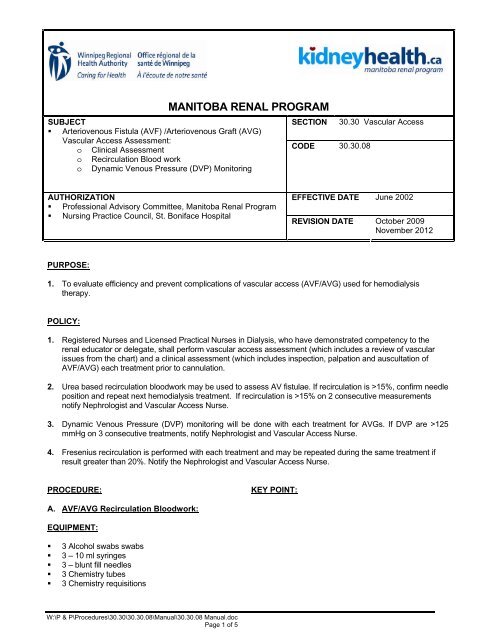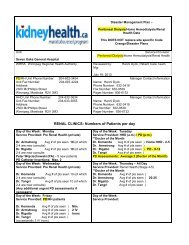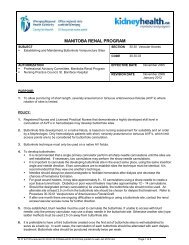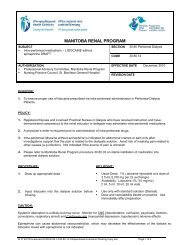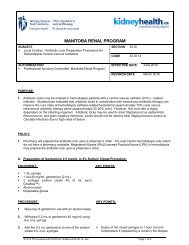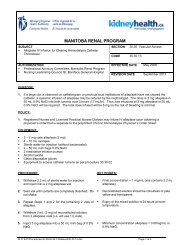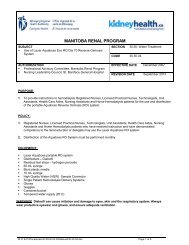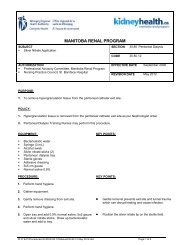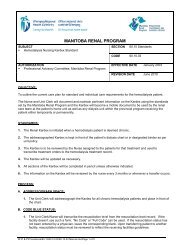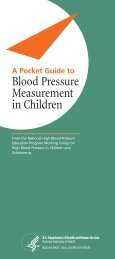30.30.08 AVF/AVG Vascular Access Assessment - Kidney Health
30.30.08 AVF/AVG Vascular Access Assessment - Kidney Health
30.30.08 AVF/AVG Vascular Access Assessment - Kidney Health
You also want an ePaper? Increase the reach of your titles
YUMPU automatically turns print PDFs into web optimized ePapers that Google loves.
MANITOBA RENAL PROGRAMSUBJECT• Arteriovenous Fistula (<strong>AVF</strong>) /Arteriovenous Graft (<strong>AVG</strong>)<strong>Vascular</strong> <strong>Access</strong> <strong>Assessment</strong>:o Clinical <strong>Assessment</strong>o Recirculation Blood worko Dynamic Venous Pressure (DVP) MonitoringSECTIONCODE <strong>30.30.08</strong>30.30 <strong>Vascular</strong> <strong>Access</strong>AUTHORIZATION• Professional Advisory Committee, Manitoba Renal Program• Nursing Practice Council, St. Boniface HospitalEFFECTIVE DATE June 2002REVISION DATE October 2009November 2012PURPOSE:1. To evaluate efficiency and prevent complications of vascular access (<strong>AVF</strong>/<strong>AVG</strong>) used for hemodialysistherapy.POLICY:1. Registered Nurses and Licensed Practical Nurses in Dialysis, who have demonstrated competency to therenal educator or delegate, shall perform vascular access assessment (which includes a review of vascularissues from the chart) and a clinical assessment (which includes inspection, palpation and auscultation of<strong>AVF</strong>/<strong>AVG</strong>) each treatment prior to cannulation.2. Urea based recirculation bloodwork may be used to assess AV fistulae. If recirculation is >15%, confirm needleposition and repeat next hemodialysis treatment. If recirculation is >15% on 2 consecutive measurementsnotify Nephrologist and <strong>Vascular</strong> <strong>Access</strong> Nurse.3. Dynamic Venous Pressure (DVP) monitoring will be done with each treatment for <strong>AVG</strong>s. If DVP are >125mmHg on 3 consecutive treatments, notify Nephrologist and <strong>Vascular</strong> <strong>Access</strong> Nurse.4. Fresenius recirculation is performed with each treatment and may be repeated during the same treatment ifresult greater than 20%. Notify the Nephrologist and <strong>Vascular</strong> <strong>Access</strong> Nurse.PROCEDURE:KEY POINT:A. <strong>AVF</strong>/<strong>AVG</strong> Recirculation Bloodwork:EQUIPMENT:• 3 Alcohol swabs swabs• 3 – 10 ml syringes• 3 – blunt fill needles• 3 Chemistry tubes• 3 Chemistry requisitionsW:\P & P\Procedures\30.30\<strong>30.30.08</strong>\Manual\<strong>30.30.08</strong> Manual.docPage 1 of 5
1. Label each chemistry tube with the appropriatepatient labels. Mark one of each of the tubesarterial, venous, and systemic.• Each blood tube requires a separate lab requisitionfor urea level.2. Obtain blood samples 15-30 minutes afterinitiation of hemodialysis.3. Press the UF Timer light off. • This will stop Ultrafiltration and therefore eliminateconvective transport4. If the patient has Na and UF profiles, the 5008reads: Stop Both Profiles or ContinueTreatment. Press Stop Both Profiles.• If the profiles are not stopped, the dialysate flowwill stop which will cause the arterial and venoussamples to be the same as there will be nodiffusion occurring. Pressing Continue will causethe UF to resume and give inaccurate results.5. Swab the arterial (red) sampling port using analcohol swab. Using the 10 ml syringe with ablunt fill needle, collect a minimum of 4.5 ml ofblood. Place in chemistry tube labelled“arterial”.6. Repeat step 5 using the venous port and placein chemistry tube labelled “venous”.7. Lower the blood flow to 120 ml/minute. • This clears recirculated blood from the access.8. After 10 seconds, turn the blood pump OFF.9. Clamp the arterial bloodline between thesampling port and dialyzer.• To prevent backflow from the dialyzer.10. Clamp venous blood line. • To prevent introduction of venous blood into thesystemic sample.11. Swab the arterial sampling port. Collect aminimum of 4.5 ml of blood from the arterialport. Place in chemistry tube labelled“systemic”.• Systemic sampling must be obtained within 15seconds of stopping the blood pump.12. Unclamp the arterial and venous bloodlinesand resume original blood flow.13. If the patient has Na and UF profiles: Press theUF menu and reset the UF profile. Press theNa Profile menu and reset the Na profile.• If less than 3.5 hours of treatment remain, will notbe able to reprogram the Na profile.14. Press the UF Timer Light ON15. The following formula is used to calculate thepercentage of recirculation:R(%) = S-A x 100S-V• Elevated levels of access recirculation will beinvestigated for the presence of vascular accessstenosis.S = SystemicV = VenousA = ArterialW:\P & P\Procedures\30.30\<strong>30.30.08</strong>\Manual\<strong>30.30.08</strong> Manual.docPage 2 of 5
R(%) = percentage of recirculationB. Dynamic Venous Pressure Monitoring for<strong>AVG</strong>s:1. Initiate hemodialysis with blood flow of 200mL/min.2. Ensure patient’s bed/chair is set to the lowestpossible level.3. Measure and record the venous pressure fromthe hemodialysis delivery system during thefirst 2 – 5 minutes of every hemodialysistreatment.• Ensure 0.9% NaCl has cleared from theextracorporeal circuit.• Assess at same level for all measurements for alltreatments. DVP will fluctuate at differentelevations.• Pressure will vary depending on the gauge of thefistula needle. If venous pressure >125 mmHg on3 consecutive treatments or increasingprogressively, notify Nephrologist and <strong>Vascular</strong><strong>Access</strong> Nurse.4. Increase blood flow (Qb) to desired rate.C. Fresenius Recirculation Measurement (On-LineRecirculation):1. The nurse must document and interpret theresults using the following guidelines:• If recirculation is low (< 10 %), it is probably acase of inevitable cardiopulmonary recirculation.• If recirculation is high (> 20 %), there is probably aconsiderable recirculation in the fistula. First checkwhether the needles are well positioned andwhether the blood lines have not been reversedbefore being connected. If the fault cannot beascertained here, the fistula should be furtherexamined for possible stenosis.• The Fresenius 5008 measures access recirculationusing the thermo dilution method of the bloodtemperature monitor (BTM). The result is displayedon the “treatment” and “BTM” option pagesapproximately 15 minutes into treatment.• Please observe that recirculation measurementimpacts dialysis efficiency. A prolongation of thetreatment should therefore be considered.• If the recirculation is between 10 and 20 %, thepatient might have a very high cardiopulmonaryrecirculation or additional fistula recirculation mightbe present. To distinguish between bothpossibilities, increase or decrease the blood flowby 100 mL/min and repeat recirculationmeasurement. If there is only a minor recirculationchange, this is an indicator for cardiopulmonaryrecirculation. If there is a considerable change(>10 %), it is more likely a case of fistularecirculation.2. To repeat the recirculation measurement,touch the Recirculation I/O button3. Notify Nephrologist and <strong>Vascular</strong> <strong>Access</strong>Nurse with results greater than 20%.D. <strong>Vascular</strong> <strong>Access</strong> <strong>Assessment</strong>:1. INSPECTIONW:\P & P\Procedures\30.30\<strong>30.30.08</strong>\Manual\<strong>30.30.08</strong> Manual.docPage 3 of 5
a. Compare arms looking for ecchymosis,erythema, discoloration of skin or anybreaks in the skin.b. Inspect access arm for aneurysms,hematomae, curves or flattening of thevessel, presence of accessory vessels,signs of steal syndrome, and previouspuncture sites.2. PALPATIONa. Assess the thrill to determine patency offistulab. Assess for the following:(i) Aneurysms(ii) Temperature – increased temp mayindicate infection(iii) Decreased temperature to distalextremity may indicate steal syndrome(iv) Pain may also indicate steal syndrome(v) Capillary refill
National <strong>Kidney</strong> Foundation. (2006). K/DOQI Clinical practice guidelines for vascular access. American Journalof <strong>Kidney</strong> Disease, 37(Suppl. 1), 137-181.ESRD network 1 October 11, 2007 Av Fistuale: Creation thru Decades-Long Performance! Janet Holland, RN,CNN director, Da Vita <strong>Vascular</strong> <strong>Access</strong> ManagementFresenius Medical Care (2010) 5008 Hemodialysis system Operating Instructions (Ed. 9/10:10). Author.W:\P & P\Procedures\30.30\<strong>30.30.08</strong>\Manual\<strong>30.30.08</strong> Manual.docPage 5 of 5


